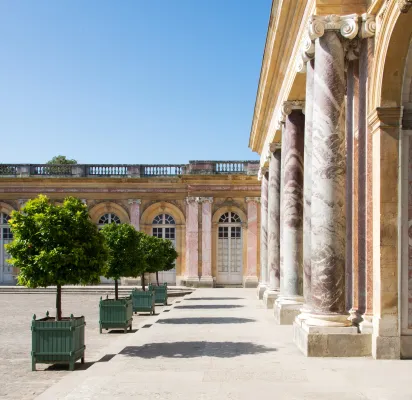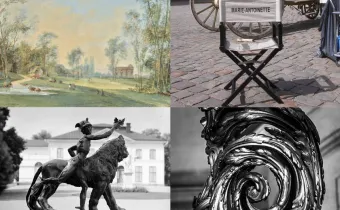Marble in trianon
Marble reigns supreme in the Grand Trianon's unique architecture desired by Louis XIV, which is caracterised by the use of multiple types of marble extracted from quarries on the facade and the peristyle: the pilasters are made of red occitan marble, the columns of green Campan on the main courtyard and of red occitan marble on the garden side, and the ionic capitals of white Carrara marble.
The marble can also be found in the gardens as in the Buffet d’eau, a remarkable piece of work built as a waterfall nearby the Grand Trianon, composed of three marble terraces of different shades: the red Languedoc marble, the Campan, the violet breccia and the white Carrara marble. The recent restoration of this emblematic fountain allows to admire it as Louis XIV did back in time, when marbles, lead figures covered by gold and springing water harmonised together creating an exceptional sight.
an original botanic creation
Gardeners selected and grew nearly 18 000 species of plants in the Trianon Estate's greenhouses, then planted them in the heart of the upper and lower Parterres to create a botanical composition that harmonises with the marmoreal architecture mostly composed by 4 colours: purple, white, light and dark pink.
The upper Parterre reproduces the smooth, flat aspects of marble through four plants that serve as the base of the composition: alternanthera (a staple of mosaiculture) and three different varieties of verbena. These plants produce flowers all at the same level, forming ans ensemble accented by snail vine, gladiolus, and Oriental lilies. The upper Parterre is thus designed as a single block of marble, blossoming as one. Mexican Daisy's grows at the base of the topiaries, while aquatic plants like waterlily and lotus thrives in the basin.
Along the Parterres, potted exotic plants stir our sense of wonder: hibiscus, protea, angel's trumpet, palm trees, and powder puffs, as well as fuchsias and bougainvillea.
The lower Parterre, plotted around the same design, is composed of twenty-three different species, often used in French gardens and particularly in Versailles. It conveys the surprising patterns of marble through different species of sage, spider flowers, cosmos, as well as begonias, carnation, and petunias. These plants of different sizes and volumes entice our regard and play with perspective.
Thanks to the patronage of:






